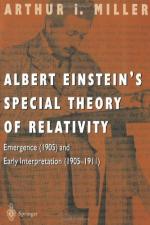|
This section contains 1,995 words (approx. 7 pages at 300 words per page) |

|
Overview
At the dawn of the twentieth century the classical laws of physics put forth by Sir Isaac Newton (1642-1727) in the late seventeenth century stood venerated and triumphant. The laws described with great accuracy the phenomena of everyday existence. A key assumption of Newtonian laws was a reliance upon an absolute frame of reference for natural phenomena. As a consequence of this assumption, scientists searched for an elusive "ether" through which light waves could pass. In one grand and sweeping "theory of special relativity," Albert Einstein (1879-1955) was able to account for the seemingly conflicting and counter-intuitive predictions stemming from work in electromagnetic radiation, experimental determinations of the constancy of the speed of light, length contraction, time dilation, and mass enlargements. A decade later, Einstein once again revolutionized concepts of space and time with the publication of...
|
This section contains 1,995 words (approx. 7 pages at 300 words per page) |

|


